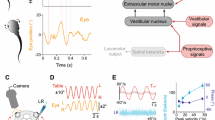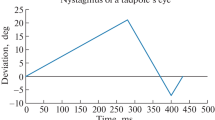Summary
-
1.
By videorecordings we studied ocular counterroll in fishes during actively and passively induced postures.
-
2.
During active body roll in response to the presence of obstacles, during Ventral Substrate Response (VSR) induced pitch-up, and during active pitchdown in a “head-standing” fish ocular counterroll occurs with the same gain as when the same posture is induced passively.
-
3.
During VSR induced roll and under certain conditions also during Dorsal Light Response (DLR) induced roll ocular counterroll is absent.
-
4.
During tail bending in the horizontal plane ocular counterrotation is more distinct during active movements than during passive ones.
-
5.
During certain cases of DLR induced roll as well as during DLR induced pitch-up and pitch-down ocular counterroll is present, but less pronounced than during passively enforced abnormal postures.
-
6.
We interpret the different types of oculomotor behavior during active changes of body posture as indicating that there are different modes of interaction between postural change commands initiated by higher CNS centers and vestibular circuits which are thereby set-point changed.
Similar content being viewed by others
Abbreviations
- DLR:
-
dorsal light response
- VSR:
-
ventral substrate response
References
Bárány, R.: Über einige Augen- und Halsmuskelreflexe bei Neugeborenen. Acta Otolaryngol. (Stockh.)1, 97–102 (1918)
Braemer, W., Braemer, H.: Über die Gleichgewichtsorientierung schrägstehender Fische. Z. vergl. Physiol.40, 529–542 (1958)
Buddenbrock, W. von: Über die Orientierung der Krebse im Raum. Zool. Jb. Abt. Allg. Zool.34, 479–515 (1914)
Easter, S.S.: Spontaneous eye movements in restrained goldfish. Vision Res.11, 333–342 (1971)
Easter, S.S., Johns, P.R., Heckenlively, D.: Horizontal compensatory eye movements in goldfish (Carassius auratus). I. The normal animal. J. comp. Physiol.92, 23–35 (1974)
Eaton, R.C., Bombardieri, R.A., Meyer, D.L.: The Mauthner-initiated startle response in teleost fish. J. Exp. Biol.66, 65–81 (1977)
Feng, A.: The role of the electrosensory system in postural control of the weakly electric fishEigenmannia virescens. J. Neurobiol.8, 429–437 (1977)
Fernald, R.D.: Fast body turns in a cichlid fish. Nature258, 228–229 (1975)
Grahe, K.: Über Halsreflexe und Vestibularisreaktionen beim Menschen. Z. HNO-Heilk.3, 550–558 (1922)
Harris, A.J.: Eye movements of the dogfishSqualus acanthias L. J. Exp. Biol.43, 107–130 (1965)
Hassler, R., Hess, W.: Experimentelle und anatomische Befunde über die Drehbewegung und ihre nervösen Apparate. Arch. Psychiatr. Nervenkr.192, 488–526 (1954)
Holst, E. von: Über den Lichtrückenreflex bei Fischen. Pubbl. Staz. Zool. Napoli15, 143–158 (1935)
Holst, E. von: Quantitative Untersuchungen über Umstimmungs-vorgänge im Zentralnervensystem. I. Der Einfluß des Appetits auf das Gleichgewichtsverhalten vonPterophyllum. Z. vergl. Physiol.31, 134–148 (1948)
Holst, E. von: Die Arbeitsweise des Statolithenapparates bei Fischen. Z. vergl. Physiol.32, 60–120 (1950)
Kleijn, A. de: Tonische Labyrinth- und Halsreflexe auf die Augen. Pflügers Arch.186, 82–97 (1921)
Lyon, E.P.: Compensatory motions in fishes. Am. J. Physiol.4, 77–82 (1900–1901)
Meyer, D.L., Bullock, T.H.: The hypothesis of sense-organ-dependent tonus mechanisms: History of a concept. Ann. N.Y.Acad. Sci.290, 3–17 (1977)
Meyer, D.L., Schott, D., Schaefer, K.-P.: Reizversuche im Tectum opticum freischwimmender Kabeljaue bzw. Dorsche. Pflügers Arch.314, 240–252 (1970)
Meyer, D.L., Heiligenberg, W., Bullock, T.H.: The ventral substrate response. A new postural control mechanism in fishes. J. comp. Physiol.109, 59–68 (1976)
Meyer, D.L., Platt, C., Distel, H.-J.: Postural control mechanisms in the upside-down catfish (Synodontis nigriventris). J. comp. Physiol.110, 323–331 (1976)
Meyer, D.L., Becker, R., Graf, W.: The ventral substrate response of fishes. Comparative investigation of the VSR about the roll and the pitch axis. J. comp. Physiol.117, 209–217 (1977)
Schaefer, K.-P., Schott, D., Meyer, D.L.: On the organization of neuronal circuits involved in the generation of the orienting response (visual grasp reflex). Fortschr. Zool.23, 199–212 (1975)
Szentágothai, J.: Die zentrale Innervation der Augenbewegungen. Arch. Psychiatr. Nervenkr.116, 721–760 (1943)
Author information
Authors and Affiliations
Additional information
Supported by the Deutsche Forschungsgemeinschaft (ME 526/6) and NSF, NIH and NASA grants to Dr. T. H. Bullock
We wish to thank Prof. T.H. Bullock and Prof. P. Glees for critically reading the manuscript.
Rights and permissions
About this article
Cite this article
Graf, W., Meyer, D.L. Eye positions in fishes suggest different modes of interaction between commands and reflexes. J. Comp. Physiol. 128, 241–250 (1978). https://doi.org/10.1007/BF00656857
Accepted:
Issue Date:
DOI: https://doi.org/10.1007/BF00656857




